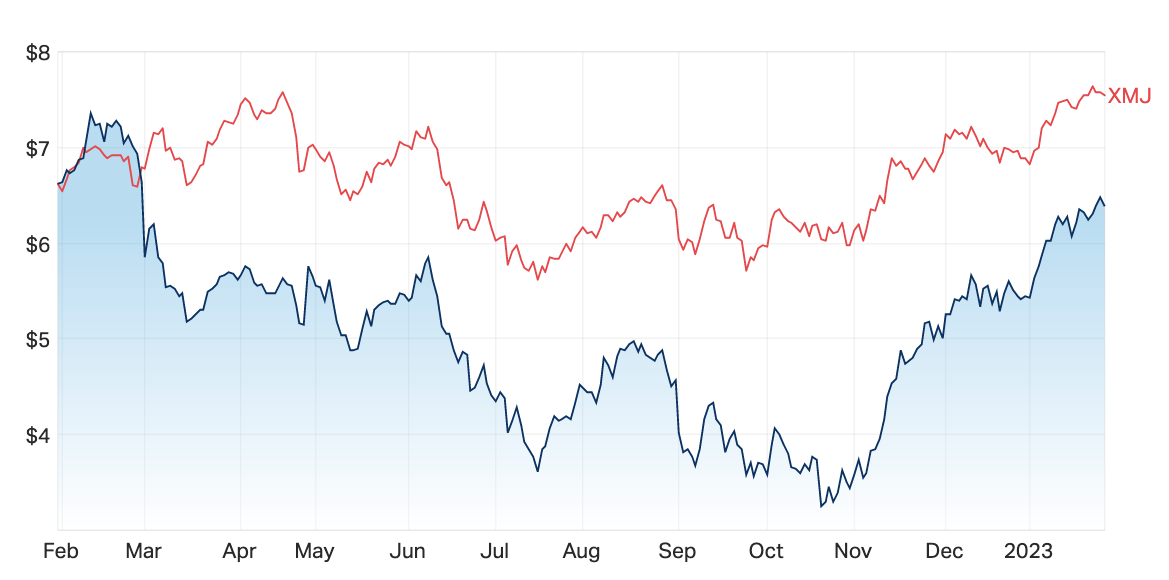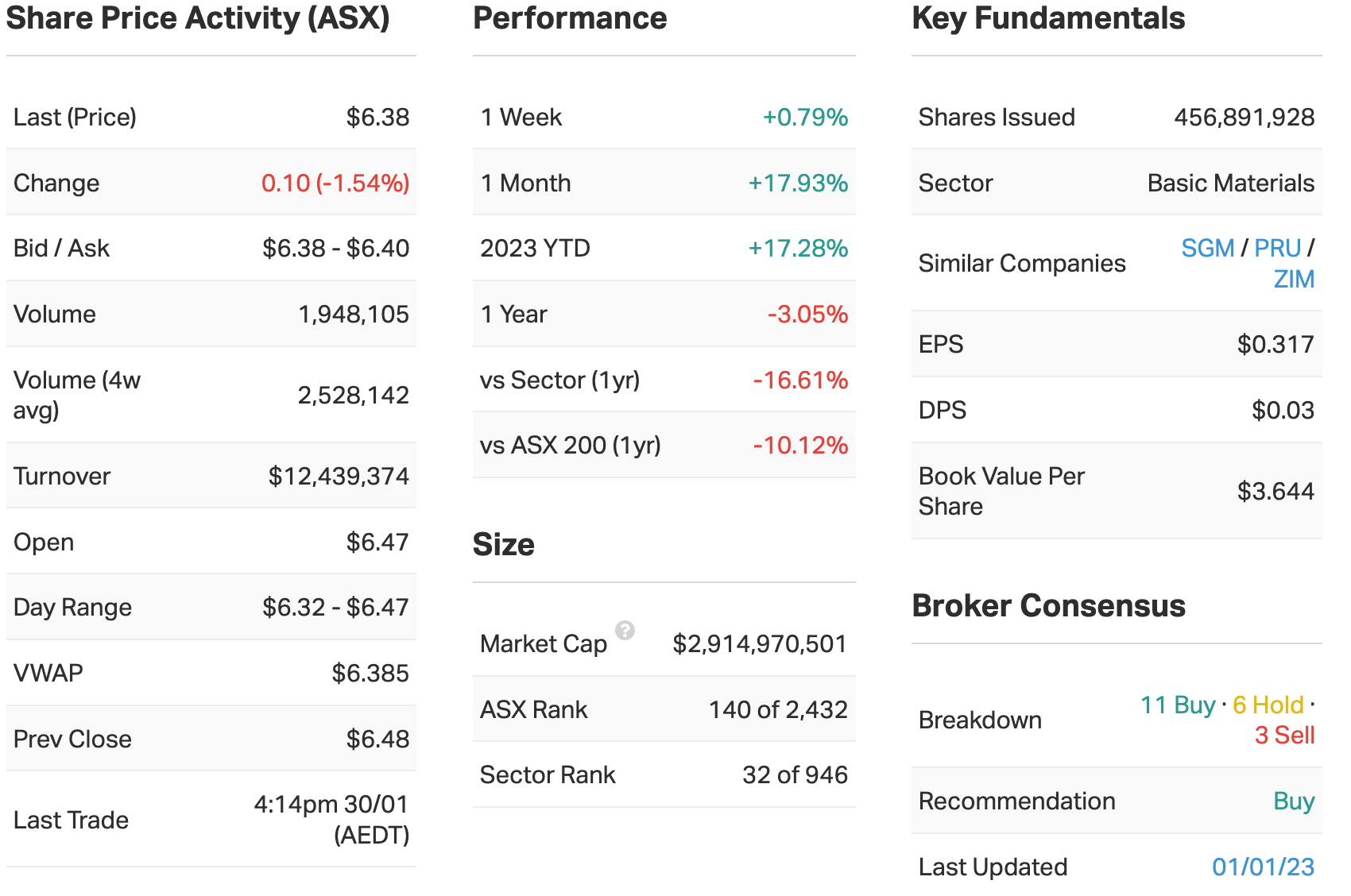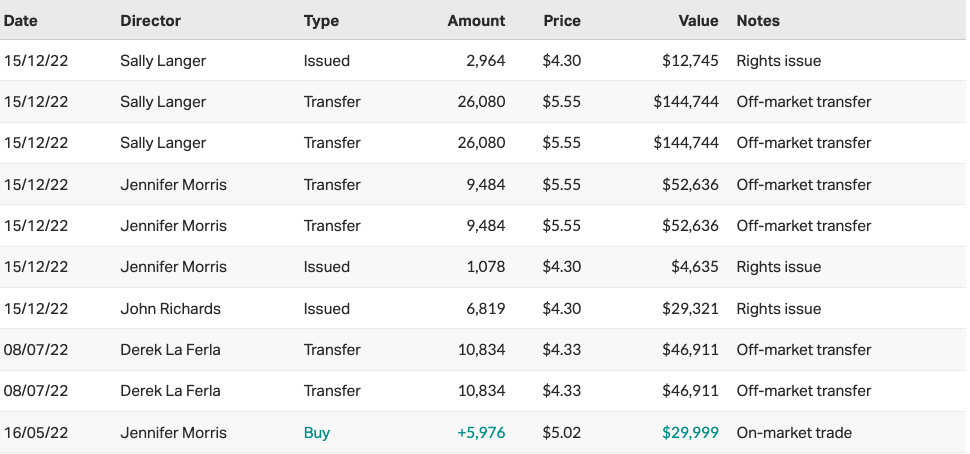The WA copper miner poised for a global breakout
Producing one of the world’s most in-demand resources, copper miner Sandfire Resources (ASX: SFR) has a box seat in the global energy transition. The red metal is key to the production of EVs and renewable energy technologies required for the push toward net zero.
In the fourth-quarter 2022 result handed down last week, management emphasised it is well-placed on its path to 120,000 tonnes a year of copper production.
“The December Quarter marked another positive and productive period for Sandfire, as we took further important steps to strengthen our balance sheet and de-risk our growth pathway against the backdrop of a strong outlook for the copper sector,” said Sandfire’s acting CEO Jason Grace.
Sandfire is undergoing a transition of its own, winding up its core DeGrussa mine in Western Australia and bringing on two new international assets in Botswana, Africa and the Huelva Province in southwestern Spain. This will see its annual copper production expand to more than 120,000 tonnes – still just a drop in the bucket of the more than 800,000 tonnes of new copper the world needs each year just to meet today’s minimum demands.
It's also preparing to bring on a new CEO, with former South32 executive Brendan Harris taking the reins in April after former chief executive Karl Simich resigned last November.
In the following interview, Darko Kuzmanovic, senior portfolio manager at Janus Henderson Investors, delves into the result. He outlines what it means for Sandfire and its shareholders, how the company is tracking within the sector, and his outlook for the business as its international footprint broadens.
Sandfire stocks closed at $6.38 on Monday 30 January. The share price gained around 5% on the day of the result, moving from $6.20 to $6.55, and is almost double its 20 October level of $3.25.
Note: This interview took place on Monday 30 January. The information below should not be considered financial advice. Investors should consult their own financial adviser before making any investment decision.

-
Sales revenue of US$217 million, up from US$214.7 million last quarter.
- Group EBITDA US$71.3 million, versus US$64.8 million last quarter.
- Cash holding of US$263.7 million, up from US$189.8 million last quarter.
- Copper production of 20,031 tonnes for the quarter, bringing the first-half total to 48,088 tonnes.
- Management is guiding toward 83,000 - 91,000 tonnes of copper production in FY2023.

What were the key takeaways from the Sandfire result? What surprised you the most?
Sandfire's results were very good, meeting and in some cases exceeding expectations. This was from a revenue, cost, and profitability perspective.
Like everything, it was a mix-and-match. The surprise was their mine in Australia, DeGrussa, which delivered better production and costs than anticipated. That mine is currently closing down because it's at the end of its life.
The result from the MATSA mine in Spain was mixed because it had some production issues with copper. But the other metals' results were better, therefore costs were under control.I'd emphasise that the de-risking process for Sandfire continues. I'm referring here to a couple of things that the market's been worried about with this stock.
One is that when management bought MATSA, they borrowed a lot of money relative to its size, so the market has been concerned about cash flow and debt. But I think this quarter has demonstrated that all look to be under control. This has been supported by a couple of things. Costs have been well managed because soon after the MATSA acquisition, European energy costs increased, which crimped margins. But that's now starting to unwind, costs are no longer rising and are now more likely to decline. Debts are also being managed.
And now we're seeing copper prices increase, having fallen over the last six months, which is driving improved cash flows. The balance sheet is robust and production is likely to grow now because another mine, Motheo in Botswana, is about complete construction. Production is expected to ramp up sometime in 2023.
How did the market respond to the result? Was this an appropriate response?
It responded much more significantly than I expected, and that's because of the de-risking aspect. Investors now seem to be saying the issues are resolved. At the same time, there are a couple of factors. This stock has had a phenomenal rally in the last three months. Rallying significantly from its lows, Sandfire is up 80% in three months and 18% in a month.
What's driving that? One thing is the rally in the copper price, which is now above $4 a pound. And the de-risking process has shifted sentiment to a more positive setting.
The other factor that's probably not well appreciated is that Oz Minerals (ASX: OZL) has now been taken out of the market by BHP (ASX: BHP). That leaves Sandfire as the only reasonable pure-play ASX-listed copper name. So, I think people are maybe recycling some of those Australian dollars into Sandfire.
Three months ago, Sandfire was ridiculously cheap for what it is and what it will become. The recent quarterly result gave more comfort that some of those uncertainties are being resolved.
The rerating occurred faster than I expected, but the extreme reaction was probably when it went the other way. It was sold off very strongly. It's now back to what I think is probably fair value. It isn't cheap and it isn't expensive. We now need to see the backfilling of the valuation by the market pricing in higher commodity prices into the future, which I think is about to happen. Most analysts have lower copper price assumptions in the next year or two.
Would you buy, hold or sell Sandfire on the back of these results?
Rating: Hold
Given the rally, it's probably a hold until we see a couple of things. One of those is a better price outlook, which I think the market's factoring in any way because it has rerated the stock.
There's also a new mine coming on in Botswana, Africa and there is uncertainty about how that will work out, how the ramp-up will occur, and whether it will meet expectations and technical criteria. But all the signs are pretty good, we just need a small pause and some more new information, which I think will become clearer over the next few quarters. I think the stock will then move higher.
What's your outlook for Sandfire and for copper miners more broadly?
As with Rare Earths and other materials required for EVs, copper is one of those commodities where most people regard supply and demand as being quite tight. We won't see any material oversupply of copper. If anything, the risk is undersupply.
For copper, each year you see around 5% to 6% of productive capacity offline due to delays including strikers, concerns around weather and other factors. That keeps the market reasonably tight from a surplus-deficit point of view. But at the same time, if this EV revolution continues, copper is one of those commodities that will be in demand.
The other thing about copper is that we need to produce, develop or bring online about 800,000 tonnes each year. That's just to meet 3% growth and replace depletion, without factoring in rising demand from EVs. So, I think the outlook for copper is very good over the medium- and long-term.
Sandfire has a very attractive growth profile, currently producing more than 60,000 tonnes of copper from DeGrussa. This figure goes to 80,000 tonnes with MATSA alone. And then you've got Motheo coming on with about 40,000 tonnes. So, it could become a more than 120,000 tonne a year producer within two years.
The challenge for these guys is what they do next. The beauty of Sandfire is that they now own assets and significant acreage. One is in the copper belt in Botswana, where they'll also be able to expand production. And it's the same thing in MATSA, where they're on the Iberian Pyrite Belt, which has been producing since Roman times. Obviously not at the same scale, but it's highly prospective.
Sandfire has all the elements that make a resource stock attractive. It's got production growth and resource growth potential, is in two great districts, and has a bullish underlying commodity.
Are there any risks to this company and its sector that investors should be aware of given the current market environment?
DeGrussa is coming offline because it's reached the end of its life, but those two mines coming online have a high potential to increase production over time because of their exploration potential and will have long lives. So it's a nice mix.
One risk is global economics. Copper prices have been to $4.50, and they dropped down to $3.50. That could happen again for whatever reason. But I think the structural setting for copper means that I don't think prices will stay at $3.50 for any length of time.
There's also the risk that Motheo doesn't work as expected and that anticipated cash flows are pushed out. But it should be straightforward. The mine is an open pit, with some underground, but it's pretty straightforward to operate.
And Sandfire is transitioning from being a West Australian miner to being an international miner, which brings uncertainties and risks. How will they manage the workforce in Botswana, and the same thing in Spain? Sandfire has gone into a country with a long history of mining. The challenge for Sandfire is to maintain this management and then optimise it.
You've also got a new CEO coming on. Though I think it's a positive appointment because he has experience in a bigger company that has multiple assets. From running one mine in WA to running three – two of which are international – is a different proposition. But I think they're dealing with that reasonably well and I think they're well-placed.
10 most recent director transactions

Access to the worlds leading resources
Darko Kuzmanovic and the team invest in high-quality mining, energy and agriculture companies with the flexibility to invest across the supply chain, taking advantage of price shifts between upstream and downstream sectors and across industries. To learn more, visit the fund profile below.

4 topics
3 stocks mentioned
1 fund mentioned
1 contributor mentioned


